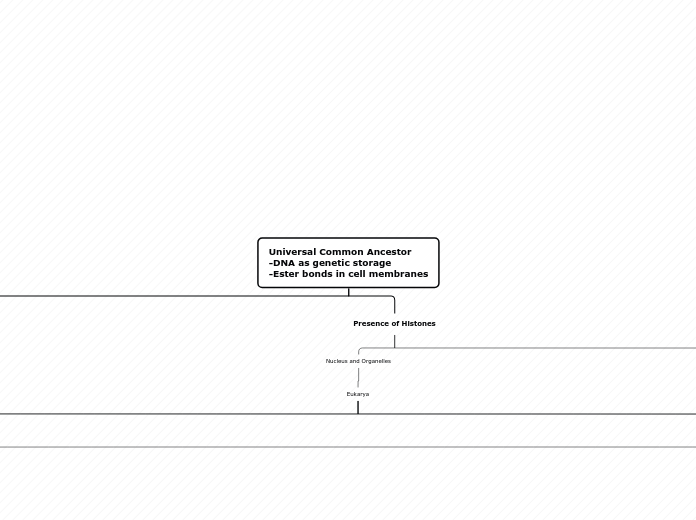by Daniel Potter 3 years ago
298
Tree organigram
The development of modern plants and animals can be traced back to a universal common ancestor. This ancestor's DNA served as the genetic blueprint and had cell membranes with ester bonds.

by Daniel Potter 3 years ago
298

More like this
Feeding groove, Secondary plastids in photosynthetic species
Excavata
Euglenoids
Unikonta
Opisthokonta
Fungi Nucleariids Common Ancestor
Nucleariids
Kingdom Fungi -Multicellularity -Chitin cell wall -Zygotic life cycle -Absorptive heterotrophy
Black Bread Mold
Fly Agaric
Animal Choanoflagellate Common Ancestor
Choanoflagellates
Kingdom Animalia -Multicellularity -Mobility -Gametic life cycle
Eumetazoa -Tissues
Bilateria -Bilateral body symmetry
Deuterostoma -Triploblasty -Radial and indeterminate embryonic cleavage -Blastophore becomes anus
Chordata -Notochord -Hollow Dorsal Nerve Cord -Post anal tail Pharyngeal slits
Vertebrate Common Ancestor -Vertebral column -Cranium
Gnathostome Common Ancestor -jaws
Osteichthyan Common Ancestor -Lungs -Bony Skeleton
Tetrapod Common Ancestor -Limbs with digits
Amniote Common Ancestor
Mammals -Hair -Milk
Reptiles
Archosaur Common Ancestor
Birds -Endothermy
Crocodilians
Lepidosaurs
Turtles
Amphibians
Lung fish
Lobe-finned fish
Ray-finned fish
Chrondrichthyes -Cartilaginous skeleton
Hagfish -Agnathans
Urochordata
Cephalochordata
-Echinodermata -Water Vascular system
Holothuroidea -No spines or endoskeleton
Echinoidea -No tube arms
Ophiuroidea -No adhesives
Asteroidea -Adhesive chemicals for gripping
Protostomia -Spiral and determinate cleavage -Blastophore becomes mouth -Cephalization
Ecdysozoa -Diploblasty -Ecdysis
Nematoda
Arthropoda
Crustacea -Specialized claw appendages
Hexapoda -Complex organ systems -Metamorphosis
Chelicerata -Claw appendages
Lophotrochozoa -Triploblasty -Trocophore and / or lophophore larvae
Platyhelminthes
Rhabditophorians -Parasitic
Trematoda -Requires host
Cestoda -Lacks mouth and gastrointestinal cavity
Annelida
Mollusca
Bivalvia -Shell divided in two
Gastropoda -soft or hard shell
Cephalopoda -Tentacles
Cnidaria -Radial symmetry -Diploplasty
Anthozoans -polyp form
Meduzozoans
Scyphozoa
Hydrozoa -polyp and medua form
Porifera
Ameobozoa
Pseudopodia
Slime Molds
Primary Plastids
Archaeplastids
Chlorophyte-Plant Common Ancestor
Plant-Charophyte Common Ancestor -Primary plastids
Kingdom Plantae Common Ancestor
-Sporic life cycle -Embryo -Dessication-resistant spores -Apical meristems -Gametangia -Sporangia
Liverworts
Common Ancestor
Mosses
Hornworts
Common Ancestor -Lignin -Xelem/Phloem -Sporophyte (dominant generation) -Thick waxy cuticle -Stomata
Lycophytes
Monilophytes
Seed Plant Common Ancestor -Ovules -Pollen -Seeds -Heterospory -Wood
Angiosperms -Fruit -Endosperm -Ovaries -Flowers
White Water Lily
Southern Magnolia
Gymnosperms
Bald Cypress
Scots Pine
Charophytes -Zygotic life cycle
Chlorophytes
Rhodophytes
SAR Clade
Secondary Plastids
Tripartite flagellar hair
Stramenopila
Giant Kelp
Diatoms
Membranous vesicles on cell membrane
Alveolata
Dinoflagellates
Filose Psuedopodia
Rhizaria
Foraminifera
Radiolarian